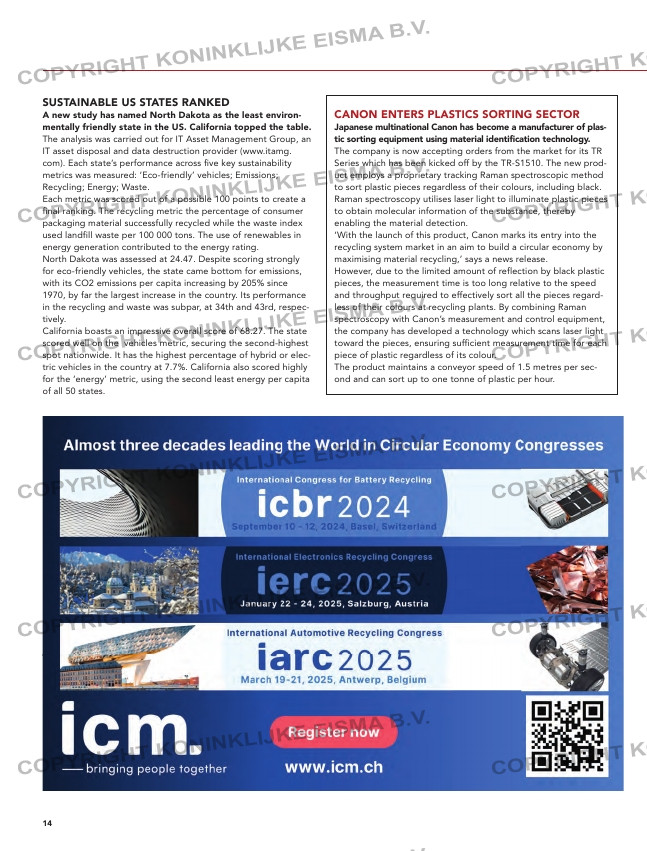Page 14 from: What’s inside issue #4?

14
ZINCFIVE BUILDS NEW US BATTERY HUB
Battery company ZincFive has secured a multi-million dollar
investment to expand its operations across the United
States.
Some of the funds will pay for a new facility near the company
headquarters in Oregon. Here, it produces nickel-zinc batter-
ies for immediate power applications such as data centres.
Company ceo Tim Hysell intends to boost the domestic bat-
tery manufacturing sector with strategic partnerships for criti-
cal materials and battery recycling. He says growing interest in
artificial intelligence, digital solutions, electric cars etc. is
prompting rocketing demand for batteries.
‘Our patented nickel-zinc electrochemistry is setting a higher
standard for battery technology that not only meets today’s
growing power demands but does so safely and sustainably,
challenging the dominance of its predecessors, lead-acid and
lithium-ion batteries,’ Hysell says.
Earlier this year, ZincFive was recognized by Time Magazine as
one of America’s top green tech companies of 2024. The com-
pany has raised over US$ 200 million (EUR 185 million) since
its launch in 2000.
SUSTAINABLE US STATES RANKED
A new study has named North Dakota as the least environ-
mentally friendly state in the US. California topped the table.
The analysis was carried out for IT Asset Management Group, an
IT asset disposal and data destruction provider (www.itamg.
com). Each state’s performance across five key sustainability
metrics was measured: ‘Eco-friendly’ vehicles; Emissions;
Recycling; Energy; Waste.
Each metric was scored out of a possible 100 points to create a
final ranking. The recycling metric the percentage of consumer
packaging material successfully recycled while the waste index
used landfill waste per 100 000 tons. The use of renewables in
energy generation contributed to the energy rating.
North Dakota was assessed at 24.47. Despite scoring strongly
for eco-friendly vehicles, the state came bottom for emissions,
with its CO2 emissions per capita increasing by 205% since
1970, by far the largest increase in the country. Its performance
in the recycling and waste was subpar, at 34th and 43rd, respec-
tively.
California boasts an impressive overall score of 68.27. The state
scored well on the vehicles metric, securing the second-highest
spot nationwide. It has the highest percentage of hybrid or elec-
tric vehicles in the country at 7.7%. California also scored highly
for the ‘energy’ metric, using the second least energy per capita
of all 50 states.
CANON ENTERS PLASTICS SORTING SECTOR
Japanese multinational Canon has become a manufacturer of plas-
tic sorting equipment using material identification technology.
The company is now accepting orders from the market for its TR
Series which has been kicked off by the TR-S1510. The new prod-
uct employs a proprietary tracking Raman spectroscopic method
to sort plastic pieces regardless of their colours, including black.
Raman spectroscopy utilises laser light to illuminate plastic pieces
to obtain molecular information of the substance, thereby
enabling the material detection.
‘With the launch of this product, Canon marks its entry into the
recycling system market in an aim to build a circular economy by
maximising material recycling,’ says a news release.
However, due to the limited amount of reflection by black plastic
pieces, the measurement time is too long relative to the speed
and throughput required to effectively sort all the pieces regard-
less of their colours at recycling plants. By combining Raman
spectroscopy with Canon’s measurement and control equipment,
the company has developed a technology which scans laser light
toward the pieces, ensuring sufficient measurement time for each
piece of plastic regardless of its colour.
The product maintains a conveyor speed of 1.5 metres per sec-
ond and can sort up to one tonne of plastic per hour.
TOMORROW’S SOLAR PANELS COULD BE MADE
WITHOUT POLYMERS
A group of US researchers
has developed a way to
make solar panels easier
to recycle. The innovation
enables glass-to-glass
welds that eliminate the
need for plastic polymer
sheets.
The US Department of
Energy’s National Renewable Energy Laboratory (NREL) is pio-
neering a laser method to produce more sustainable solar panels.
It uses an extremely short pulse (femtosecond) of infrared light
that melts the glass together to form a strong, hermetic seal.
The welding technique can be used on any solar technology: sili-
con, perovskite or cadmium telluride because the heat of the weld
is confined to a few millimetres of the laser focus.
‘As long as the glass doesn’t break, the weld is not going to
break,’ reports NREL scientist David Young. At end-of-life stage,
modules with this type of laser welding can be shattered to enable
disassembly. ‘The glass and metal wires running through the solar
cells can be easily recycled, and the silicon can be reused.’
Young says most recyclers confirm that polymers are ‘the main
issue’ when recycling solar panels. That’s because semiconductors
are typically sandwiched between two sheets of glass laminated
together with polymer sheets.
‘Our paper showed that with proper mounting and a modification
to the embossed features of the rolled glass, a welded module
can be made stiff enough to pass static load testing,’ Young notes.
NREL’s research is the first to use a femtosecond laser in a mod-
ule. The method also offers improved thermal properties and
superior strength at a compelling cost.
10-11-12-13-14-15_trendsupdatesi.indd 14 03-07-2024 12:22



